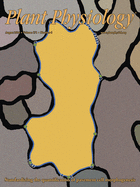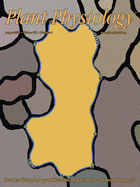
Cover image

On the Cover: In dicot leaves, epidermal pavement cells morph from a simple polyhedron to an interdigitated and highly lobed shape. Given the importance of pavement cells for the growth and mechanical stability of leaves, a quantitative analysis of their morphogenesis is critical. Wu et al. (pages 2331–2342) describe a convex hull-based algorithm termed LobeFinder, which uses the XY coordinates of the cell perimeter to locate cell lobes. This new phenotyping tool provides a standardized method to quantify and track lobe formation events. LobeFinder also creates a graphical output to map cell geometry over time. The cover image shows a field of epidermal cells, and the XY coordinates of the center cell were analyzed using LobeFinder. The artwork was created by Samuel A. Belteton. The confocal image was captured by Russell S. Julian.
Volume 171, Issue 4, August 2016
ON THE INSIDE
On the Inside
COMMENTARY
Moving toward Light in Response to a Gas: A Novel Cyanobacterial Ethylene Receptor
TOPICAL REVIEWS
Chloroplast Proteases: Updates on Proteolysis within and across Suborganellar Compartments
Homeostasis and remodeling of the chloroplast proteome involve various “processing” and “processive” proteases.
Evolution of Gene Duplication in Plants
Gene duplicates are prevalent in plants and in some cases contribute to evolutionary novelty.
BREAKTHROUGH TECHNOLOGIES
Chloroplast-Specific in Vivo Ca2+ Imaging Using Yellow Cameleon Fluorescent Protein Sensors Reveals Organelle-Autonomous Ca2+ Signatures in the Stroma
Plants expressing a chloroplast-localized Cameleon Ca2+ probe allow single-organelle analysis of chloroplast Ca2+ dynamics.
LobeFinder: A Convex Hull-Based Method for Quantitative Boundary Analyses of Lobed Plant Cells
LobeFinder, a new convex hull-based cell phenotyping tool, creates a coordinate system for cell boundary changes and detects lobe positions in epidermal pavement cells.
Expression Pattern Similarities Support the Prediction of Orthologs Retaining Common Functions after Gene Duplication Events
Expressologs identify functional orthologs and will be a powerful tool in future orthology assignment.
SCIENTIFIC CORRESPONDENCE
The Developmental Basis of Stomatal Density and Flux
Equations for stomatal density and maximum theoretical stomatal conductance as functions of stomatal initiation rate, epidermal cell size, and stomatal size enable scaling from development to flux.
Inositol Polyphosphate Binding Specificity of the Jasmonate Receptor Complex
Inositol polyphosphate binding specificity of the jasmonate receptor is largely determined by the F-box protein COI1.
RESEARCH REPORT
Isolation of Cells Specialized in Anticancer Alkaloid Metabolism by Fluorescence-Activated Cell Sorting
Idioblasts from Catharanthus roseus leaves specifically accumulate alkaloids and show autofluorescence that enabled the fluorescence-activated cell sorting of a population of idioblast protoplasts.
UPDATE
FERONIA and Her Pals: Functions and Mechanisms
Current research into the FERONIA family of receptor kinases highlights both questions and opportunities for understanding signaling strategies in plant growth and survival.
Articles
BIOCHEMISTRY AND METABOLISM
Microalgae Synthesize Hydrocarbons from Long-Chain Fatty Acids via a Light-Dependent Pathway
A pathway converting C16 and C18 fatty acids to alkanes or alkenes, involving the light-dependent transformation of cis-vaccenic acid into 7-heptadecene, is present in various microalgae.
Saturating Light Induces Sustained Accumulation of Oil in Plastidal Lipid Droplets in Chlamydomonas reinhardtii
Saturating light induces oil storage in Chlamydomonas reinhardtii, and the newly formed oil accumulates in lipid droplets distinct in protein and lipid compositions from those induced by nitrogen starvation.
Evolution of Xylan Substitution Patterns in Gymnosperms and Angiosperms: Implications for Xylan Interaction with Cellulose
The xylan decoration pattern in all lineages of gymnosperms permits hydrogen bonding of xylan to cellulose.
Molecular Evolution and Functional Characterization of a Bifunctional Decarboxylase Involved in Lycopodium Alkaloid Biosynthesis
Production of plant lysine-derived alkaloids originates with the convergent evolution of lysine decarboxylase.
The Relationship of Triacylglycerol and Starch Accumulation to Carbon and Energy Flows during Nutrient Deprivation in Chlamydomonas reinhardtii
Overflow in triacylglycerol is insufficient to explain carbon storage during nutrient deprivation.
Two Cytochrome P450 Monooxygenases Catalyze Early Hydroxylation Steps in the Potato Steroid Glycoalkaloid Biosynthetic Pathway
Silencing two cytochome P450 genes reduces steroidal glycoalkaloid content and stops tuber sprouting.
Light Remodels Lipid Biosynthesis in Nannochloropsis gaditana by Modulating Carbon Partitioning between Organelles
Light availability remodels carbon partitioning between organelles toward a greater TAG accumulation in Nannochloropsis gaditana.
A Stilbenoid-Specific Prenyltransferase Utilizes Dimethylallyl Pyrophosphate from the Plastidic Terpenoid Pathway
Stilbene prenyltransferase that utilizes DMAPP from the plastidic terpenoid pathway shows a high substrate specificity.
Coordinate Regulation of Metabolite Glycosylation and Stress Hormone Biosynthesis by TT8 in Arabidopsis
Processes that generate metabolite diversity and reprogram hormone biosynthesis are coordinately regulated to impart stress tolerance in Arabidopsis.
CELL BIOLOGY
Lack of FTSH4 Protease Affects Protein Carbonylation, Mitochondrial Morphology, and Phospholipid Content in Mitochondria of Arabidopsis: New Insights into a Complex Interplay
Plants devoid of FTSH4, one of the ATP-dependent metalloproteases in mitochondria, reveal an increased number of abnormal mitochondria, decreased respiratory complexes, and lower amounts of cardiolipins, which is suggested to cause the observed accumulation of oxidative damage.
Different Pathways Act Downstream of the CEP Peptide Receptor CRA2 to Regulate Lateral Root and Nodule Development
C-terminally encoded peptides together with the CRA2 receptor regulate nodulation and lateral root development through ethylene-dependent and ethylene-independent pathways, respectively, in Medicago truncatula.
ECOPHYSIOLOGY AND SUSTAINABILITY
Rubisco Catalytic Properties and Temperature Response in Crops
Variability in Rubisco kinetic parameters and their temperature dependency demonstrate differences in photosynthetic efficiency in the most important crops worldwide.
Rice Root Architectural Plasticity Traits and Genetic Regions for Adaptability to Variable Cultivation and Stress Conditions
Rice root genetic regions determining root architectural plasticity can be used for selection of improved adaptability to variable conditions.
Alarm Photosynthesis: Calcium Oxalate Crystals as an Internal CO2 Source in Plants
A new photosynthetic path named “alarm photosynthesis” uses mesophyll calcium oxalate crystals as the CO2 source when stomata are closed, providing adaptive advantages under drought conditions.
GENES, DEVELOPMENT, AND EVOLUTION
A Collection of Conserved Noncoding Sequences to Study Gene Regulation in Flowering Plants
Comparative sequence analysis delineates conserved noncoding sequences that are functionally relevant, a subset of which are conserved throughout green plants.
Functional Promiscuity of Two Divergent Paralogs of Type III Plant Polyketide Synthases
Evolutionary and functional divergence of gene paralogs expressing polyketide synthases from Rheum emodi play into secondary metabolism and substrate selectivities.
mRNA Decay of Most Arabidopsis miRNA Targets Requires Slicer Activity of AGO1
The majority of miRNA targets require slicer activity of ARGONAUTE1 for repression at the mRNA level.
nana plant2 Encodes a Maize Ortholog of the Arabidopsis Brassinosteroid Biosynthesis Gene DWARF1, Identifying Developmental Interactions between Brassinosteroids and Gibberellins
nana plant2 encodes an enzyme in the brassinosteroid biosynthetic pathway, and brassinosteroid and gibberellin interact in a developmentally specific manner to control maize architecture.
The Juvenile Phase of Maize Sees Upregulation of Stress-Response Genes and Is Extended by Exogenous Jasmonic Acid
The juvenile phase of maize is correlated with elevated expression of stress-related genes.
Sequence Polymorphisms at the REDUCED DORMANCY5 Pseudophosphatase Underlie Natural Variation in Arabidopsis Dormancy
DELAY OF GERMINATION18 QTL encodes a pseudophosphatase, involved in seed dormancy regulation.
Different Alleles of a Gene Encoding Leucoanthocyanidin Reductase (PaLAR3) Influence Resistance against the Fungus Heterobasidion parviporum in Picea abies
Two alleles contributing to phenolic secondary metabolism provide markers for pathogen resistance in Norway spruce and have differential effects on resistance.
Protocorms and Protocorm-Like Bodies Are Molecularly Distinct from Zygotic Embryonic Tissues in Phalaenopsis aphrodite
Protocorm-like body development does not utilize the somatic embryogenesis program in Phalaenopsis aphrodite.
SUPPRESSOR OF PHYTOCHROME B4-#3 Represses Genes Associated with Auxin Signaling to Modulate Hypocotyl Growth
SOB3 modulates seedling elongation by repressing the expression of genes associated with auxin signaling.
MEMBRANES, TRANSPORT, AND BIOENERGETICS
Chlamydomonas reinhardtii PsbS Protein Is Functional and Accumulates Rapidly and Transiently under High Light
Photoprotective proteins PsbS and LhcSR3 accumulate rapidly in the photosynthetic membrane of Chlamydomonas during highlight stress with PsbS activating nonphotochemical quenching.
The Plasma Membrane H+-ATPase AHA1 Plays a Major Role in Stomatal Opening in Response to Blue Light
Mutation of the gene for AHA1, an H+-ATPase isoform, provides new insights into the stomatal regulation of Arabidopsis in response to blue light.
SIGNALING AND RESPONSE
Mutational Evidence for the Critical Role of CBF Transcription Factors in Cold Acclimation in Arabidopsis
The three CBF genes are essential for freezing tolerance and affect seedling development and salt tolerance.
The ERF11 Transcription Factor Promotes Internode Elongation by Activating Gibberellin Biosynthesis and Signaling
The transcription factor AtERF11 promotes stem growth by increasing GA biosynthesis and GA response in Arabidopsis.
The WRKY57 Transcription Factor Affects the Expression of Jasmonate ZIM-Domain Genes Transcriptionally to Compromise Botrytis cinerea Resistance
The negative role of AtWRKY57 in Botrytis infection results from transcriptional competition between transcription factors WRKY57 and WRKY33 and their actions on downstream target JAZ1 and JAZ5 genes.
Maize and Arabidopsis ARGOS Proteins Interact with Ethylene Receptor Signaling Complex, Supporting a Regulatory Role for ARGOS in Ethylene Signal Transduction
ARGOS proteins regulate ethylene signal transduction via protein-protein interactions.
Ethylene Regulates the Physiology of the Cyanobacterium Synechocystis sp. PCC 6803 via an Ethylene Receptor
Ethylene modulates the physiology of Synechocystis sp. PCC 6803 via the SynEtr1 ethylene receptor.
Feedback Regulation of ABA Signaling and Biosynthesis by a bZIP Transcription Factor Targets Drought-Resistance-Related Genes
Abscisic acid signaling and biosynthesis are feedback-regulated by transcription factor OsbZIP23 that targets diverse genes involved in drought resilience.
New Constitutively Active Phytochromes Exhibit Light-Independent Signaling Activity
Characterization of new constitutively active mutants of phytochromes reveals that both biologically active structure and nuclear localization are crucial for the light-independent function in plants.
The THO/TREX Complex Active in miRNA Biogenesis Negatively Regulates Root-Associated Acid Phosphatase Activity Induced by Phosphate Starvation
The THO/TREX complex negatively regulates phosphate starvation-induced root-associated acid phosphatase activity by suppressing ethylene signaling in Arabidopsis.
A NAP-Family Histone Chaperone Functions in Abiotic Stress Response and Adaptation
A functional H3/H4 histone chaperone mediates abiotic stress adaptation via transcriptional regulation of diverse stress-related genes in rice.


